For the Practitioner, Upasaka,Wanderer, Traveler,Seeker and all those on a journey of Self Discovery!
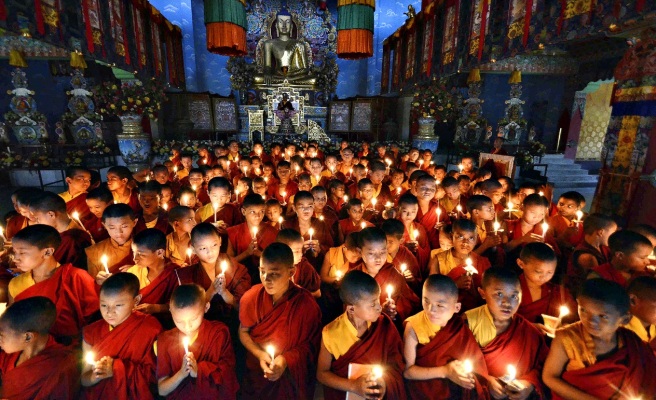
Introduction
Nepal, officially the Federal Democratic Republic of Nepal is a landlocked country, sandwiched between [Chinese Occupied] Tibet in the North and Republic of India to the South with a population of 26.4 million.
It is separated from Bangladesh by a narrow Indian corridor and from Bhutan by the Indian state of Sikkim.
Nepal is located in the Himalayas and is home to eight of the world’s ten tallest mountains, including Mount Everest (Nepali – Sagarmatha and Tibetan – Chomolungma ), the highest point on Earth.
The collision between the Indian subcontinent and Eurasia, which started in Palaeogene period and continues today, produced the Himalaya and the Tibetan Plateau. Nepal lies completely within this collision zone, occupying the central sector of the Himalayan arc, nearly one-third of the 2,400 km (1,500 mi) long Himalayas.
Nepal is divided into Three Physiographic Areas: The Northern Snow Mountains, The Middle Hilly Region, and the Southern Terai. While the Northern Region has Tibetan influence, the Southern Region has Indian.
The dramatic differences in elevation found in Nepal result in a variety of biomes, from tropical savannas along the Indian border, to subtropical broadleaf and coniferous forests in the Hill Region, to temperate broadleaf and coniferous forests on the slopes of the Himalaya, to montane grasslands and shrub lands and rock and ice at the highest elevations.
Nepal is a multiethnic nation with Nepali as the official language. Kathmandu is the nation’s capital and largest city. Modern Nepal is a secular parliamentary republic.
Though Buddhism is now a minority faith in Nepal and Buddhists comprise less than 10% of Nepal’s population, Buddhism in Nepal dates from the birth of Siddhartha Gautama himself.
Legend has it that many Bodhisattvas and previous Buddha’s also visited the land. Monuments to these Buddha’s can still be seen. Early Buddhist history is difficult to document, but we know that Nepal became a great meeting point for Indian and Tibetan Buddhist teachers.
Nagarjuna, the great Madhyamika master, and many other great practitioners visited, lived, and taught in Nepal. Stone inscriptions and colophons provide clear evidence that a strong lineage of Mahasanghika Bhiksuni’s existed in the seventh century.
The country became a repository of Buddhist Sanskrit literature and famous for its production of fine Buddhist art.
Many famous temples have been erected throughout Nepal. Although many ancient temples were destroyed by earthquakes in 1355 and 1934, many important religious structures still survive.
The ancient stupas of Swayambhu and Bodhnath are regarded as most sacred. Buddhism in Nepal includes Theravada, Mahayana and Vajrayana traditions. The rulers of Nepal have primarily been Hindu, but have supported the development of Buddhism over the centuries.
The Tibetan Mahayana tradition is the most popular in northern Nepal, with approximately 3000 monasteries. Newar Vajrayana Buddhism is a widespread religious system in the Kathmandu Valley with an elaborate tradition of ritual. Since the early 40s some Nepalese have turned to Theravada practice based on the Pali canon, stressing the rational aspects of Buddhism over ritual.
Most Theravada monasteries are located in the Kathmandu Valley. There are approximately 100 monks and 150 nuns, mostly belonging to the Newar community. Newars with the Shakya surname trace their lineage to the family of Shakyamuni Buddha.
Indian Buddhism began to penetrate the mountain passes into Nepal in perhaps the 4th or 5th century AD, although its influence has always been mainly confined to the Kathmandu Valley and the western part of the country.
With the destruction of Buddhism in India in the 13th century, Tibet, Nepal’s powerful neighbour to the north, began to influence the country’s religious development. However, the Tantric Buddhism that resulted became increasingly corrupt and fused with Hinduism, the predominant religion, and the two became and remain even today almost indistinguishable.
In the 1930s the first Nepalese ordained as Theravada monks in India, but Nepal’s Hindu rulers refused to allow them to return to the country and imprisoned those who did. With the change of government in 1950 and the coming of religious freedom, Theravada Buddhism has begun to steadily gain support.
After the Communist Chinese takeover of Tibet, Tibetan refugees have also established themselves in the country and their presence has helped to some extent to revive traditional Nepalese Buddhism.
Until recently, nuns in Nepal took ten precepts and did not have access to full ordination. In 1988 a group of nuns went to Los Angeles, California to receive full ordination as Bhikkhunis. In 1998 other Nepali nuns received Bhikkhuni ordination in China and Bodhgaya, India.
In 1999 in Lumbini, Bhikkhuni Dhammavati organized the first Siksmana ordination to be held in Nepal in 1000 years.
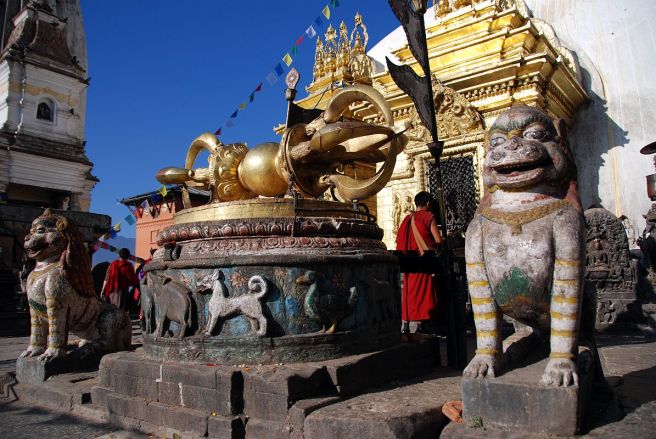
Buddhist Sites of Nepal
For Buddhist traveler ‘s / pilgrim’s visiting India’s Buddhist holy sites, without visit to Nepal’s Buddhist sites is a pilgrimage incomplete since both countries are connected by Buddha’s Dhamma, Buddha Sakyamuni is ingrained in the spirit of India and Nepal.
A spiritual philosopher and sage of all sages, Siddhartha Gautama Buddha was born in Lumbini, Nepal and spent his whole life in North India in search of his life’s motive. In his late 20’s, he witnessed ‘the four great signs’ in the form of an old man, a sick man and a corpse and a meditating ascetic. These four sights changed his whole vision of life and he renounced his material wealth for ultimate enlightenment.
This fruitful journey of life brings pilgrims close to the Buddhist places of worship in Nepal. During this sacred journey, the believers can gain merit of travelling with the fellow Buddhists and monks to embrace the spirit of learning as established by Buddha.
Besides the already famous sites of Lumbini, Boudhanath, Swayambhunath and Patan, I have also included lesser known / unknown sites of Buddhist culture that will appeal to the visiting tourists / pilgrims. So let’s start our pilgrimage of Buddhist holy sites of Nepal from Lumbini.
Lumbini

Sakyamuni Buddha was born in Lumbini, in southern Nepal, 2500 years ago. Since his time, Nepal has been a sacred ground for Buddhists as the birthplace of the Buddha.
Lumbini is a small town in the southern Terai plains of Nepal, where the ruins of the old city can still be seen. Sakyamuni Buddha was born to a royal family, his mother, Queen Maya Devi, has a dream for telling his coming. In her dream, she saw a white elephant with nine tusks come down to her from the heavens and enter her body. When the time of his delivery approached, she left for her parental home, according to the practice of the time. En route to her parents’ home, she gave birth to Siddhartha Gautama in the gardens of Lumbini.
The prince is said to have emerged from her right side as she rested her arm on the branch of a fig tree and immediately after birth, he took seven steps in the four cardinal directions and wherever his feet touched the ground, a lotus bloomed.
Lumbini and its surroundings are dotted with archeological sites related with Lord Buddha. There are over 60 excavation sites among which some of them are popular Buddhist pilgrimage sites. The legendary Lumbini garden is now developed into a sanctuary that spread over the 6 sq km area.
The Mayadevi temple houses the marker stone and foundation of ancient temple resembling the exact birthplace of Lord Buddha. Monastic zone is developed into World Buddhist center with monasteries constructed by Buddhist communities from different countries. Ruins of Tilaurakot palace has been discovered 27 km west of Lumbini.
Tilaurakot is ancient capital of Sakya kingdom (Kapilavastu) where Siddhartha lived his early 29 years as a prince. Along with other structures, one can still observe the remains of the eastern gate through which Prince Siddhartha took great renunciation.
Ramgram Stupa is the only Stupa which still retains Buddha relic in its intact form. When Buddha attained ‘Mahaparinirvana’, his body was cremated. The mortal relic was divided among the 8 claimants. While other Stupas were later excavated by Emperor Ashoka or distorted in conflict, the relic remained intact until the date in the Ramagram Stupa.
Kudan (Nigrodharma) has the stupa remains, where King Suddhodhana (father of Buddha) met Lord Buddha after he attained enlightenment. Gotihawa was ancient Khemavati the birth place of Krakucchanda Buddha. Niglihawa is the birthplace of Kanakmuni Buddha. Emperor Ashoka visited both places and erected pillars with inscriptions. The pillars are broken in both places.
Sagarhawa is the place where Sakyas were massacred by King Virudhaka out of vengeance. About 70,000 Sakyas were killed in the massacre. The Sakyas didn’t strike back as they believed in nonviolence.
Boudhanath
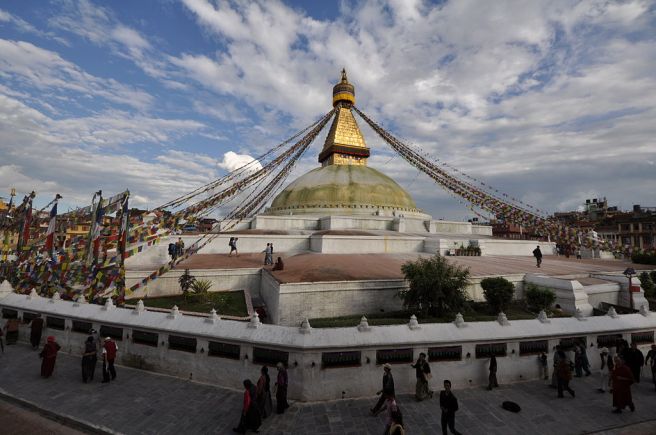
Boudhanath also called Boudha, Bouddhanath or Baudhanath or the Khasa Caitya is a stupa in Kathmandu, Nepal. It is known as Khasti in Nepal Bhasa, Jyarung Khashor in Tibetan language or as Bauddha by speakers of Nepali.
Located about 11 km (6.8 mi) from the center and northeastern outskirts of Kathmandu, the stupa’s massive mandala makes it one of the largest spherical stupas in Nepal. It is a UNESCO World Heritage Site.
There are many stories and legends concerning the origin and history of the great stupa. According to “Hidden Treasure of the Guru Padmasambhava” a widow named Ma Jhyazima aspired to make a great offering of the Boudha, using her hard-earned saving as a poultry keeper, she approached the local king for permission and it was granted , on condition that she used an area of the land measuring the size of a single ox skin.
However, Jhyazima cut the skin into thin strips and claimed the land enclosed from the strips lay end to end. This mere woman’s ambition to build such a magnificent monument offering to the Boudha caused much jealousy between the rich and powerful at the time.
The jealous lord petitioned the king to stop the construction, but the king who had allowed this happen, replied – “Since permission to build has been given, it shall not be rescinded.” Thus the meaning of the stupa named Jhyarung Khashyor.
The remaining work of the construction of Boudha stupa was completed by the four sons (Trisong Deuchen, Shanta Rakshita, Guru Padmasambhava, Bami Thiser), of Jhyazima. This legend is very much popular in Himalayan Buddhist society.
The earliest historical references to the Boudha Stupa are found in the Chronicles of the Newars. Firstly, Boudha is mentioned as one of the four stupas found by the Licchavi king Vrisadeva (ca.AD 400) or Vikramjit. Secondly, the Newars legend of the stupa’s origin attributes it to king Dharmadeva’s son, Manadeva as atonement for his un writing parricide Manadeva was the great Licchavi king, military conqueror and the patron of the arts who reigned ca.AD 464-505.
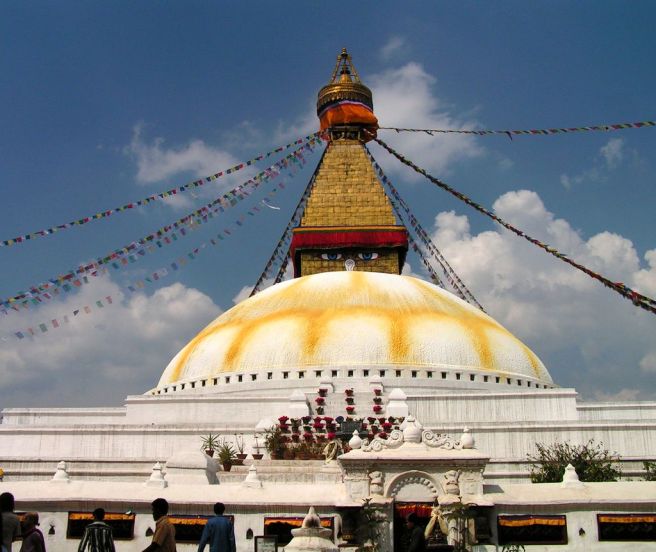
Manadeva is also linked with the Swayambhu Chaitya of Gum Bahal. Thirdly, another great Licchhavi king Shivadeva (AD 590-604) is associated with Boudha by an inscription; he may have restored the Stupa. Finally in the archeological report of the 16th century Tibetan restorer, Sakya zangpo, there is an assertion that he discovered the Lichhavi king Amsuvarma’s relics in the Stupa.
There are no Lichhavi stone remains in the vicinity of Boudha, although in the eastern enclave of the Stupa there are several updatable but undoubtedly ancient stones inscribed with mantra, and in the south there are small Chaityas in the Lichhavi style, which could perhaps be dated as early as the 13th century.
In conclusion, although there is no epigraphical or reliable archeological or literary evidence of the Stupa’s Lichhavi origins, its early history being based entirely upon legend.
Clues to the Stupa’s origin and history can be derived from the etymology of the Newari name of the Stupas Khas or Khasti Chaitya, “The Dewdrop Stupa”. Some believe the name derives from Kasyapa, the Manusi Buddha of the Dwapara-yuga, whose relics are said to be enshrined within it .According to Newari etymology it is derived from the Newari word for dew, for the chronicles mention that when the Stupa was in process of construction a drought struck and the workmen were forced to lay out white cotton cloth to collect the morning dew, which was then wrung out to facilitate the day’s construction.
Some say Khasa was the name of a Tibetan Lama whose relics were interred here, or that the Stupa’s origin was in some way associated with the town Khasa on the present border of Nepal and China.
According to Gopal Raj Chronicles during the reign of the Licchavi king Dharmadeva (ca.AD 4th century), it is said that the king installed “Narayanhiti ” tap but the water did not come. So, the king consulted his astrologers and was told that for water, the sacrifice of the most virtuous man in the kingdom was required.
After disappointing results, the king decided that it was only himself and his son who qualified as victims. The old king decided it was to be himself to die, and instructed his son to decapitate with one stroke a shrouded form he would find lying near the palace that night.
The son prince Manadeva obeyed his father’s command and was horrified to see the head of his father fly from the corpse. It landed at the temple of Vajra Yogini in Sankhu and he was told by the goddess that the only way he could undo his sins was to let a cock fly, and wherever the cock landed, build a Stupa for his father’s remains. The cock alighted at Boudha, and king Manadeva built magnificent Stupa there.
Ngakchang Sakya Zangpo, a Nyingmapa Tantric master lived who lived during the 15th Century AD, constructed the stupa, probably in the same form that stands today. In 19th Century AD Jogchen Shyabkar Chokdrual Rangdol kept gold-plated copper in the Harmika of Stupa.
Then in 1918, Shakya Tokden Shree contributed in restoration of this Stupa. He spent all the money collected in Tibet in the restoration of Boudha Stupa. Similarly, in 1919 his sons completed the work of restoration of the Stupa. The modern history of Boudha Stupa is related to the Chiniya Lama tradition.
In 1859 A.D. Rana Prime Minister appointed Chiniya Tai Fo Sing as the priest Boudha Stupa. He and his generation contributed in the restoration of Stupa. And different dharma masters had played a vital role for the restoration of this great stupa. Amongst the people who worship and play a vital role in preserving the Stupa, the Tamang community forms the nuclear part.
However, the Tibetan community now forms the numerical dominant and most active community of devotees. The Newars and Sherpas are also a part of many ethnic groups that keep this ancient site of worship alive and sacred today as it was centuries ago. The recent restorations are an effort to preserve this monument for the many more generation to come.
Swayambhunath
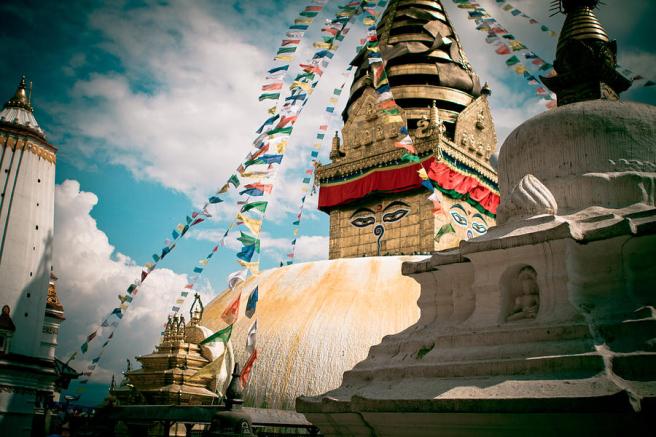
Swayambhunath is an ancient religious architecture atop a hill in the Kathmandu Valley, west of Kathmandu city. The Tibetan name for the site means ‘Sublime Trees’, for the many varieties of trees found on the hill.
However, Shing.kun may be a corruption of the local Nepal Bhasa name for the complex, Singgu, meaning ‘self-sprung’.
For the Buddhist Newars in whose mythological history and origin myth as well as day-to-day religious practice, Swayambhunath occupies a central position, it is probably the most sacred among Buddhist pilgrimage sites. For Tibetans and followers of Tibetan Buddhism, it is second only to Boudhanath.
The Swayambhunath complex consists of a stupa, a variety of shrines and temples, some dating back to the Licchavi period. A Tibetan monastery, museum and library are more recent additions. The stupa has Buddha’s eyes and eyebrows painted on. Between them, the number one (in Devanagari script) is painted in the fashion of a nose.
Swayambhu means self-arisen. This particular stupa complex was built, according to different traditions, either around a small crystal stupa that arose spontaneously on top of this hill, or a lotus flower, which naturally radiated light, at the time of the Buddha Shikhin.
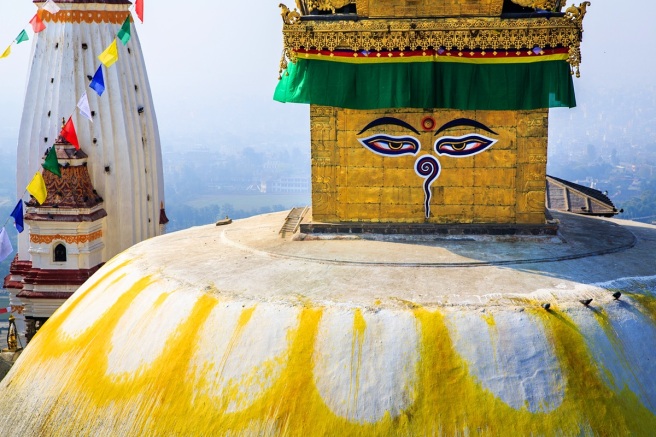
The Swayambhunath Hill which, according to Trulshik Rinpoche, has been blessed by thousands of buddhas and will be blessed by all the buddhas of this kalpa, is often considered the most sacred spot in the whole of the Kathmandu Valley. According to the Seventh Dalai Lama, this very stupa is the source of all the happiness in the world.
According to the traditional accounts the stupa was in the middle of a vast lake when Mañjushri and two friends saw it on their way from Wu Tai Shan in China to Nepal. Mañjushri found the stupa to be so incredible that he wondered how he might make it possible for pilgrims to walk to the stupa for their devotional practices.
So he cut the mountain with his sword and the water poured out for four days and four nights, producing the Madara Lake (Wyl. mtsho ral gri) in Chobar in the South-East of Kathmandu, which is on the way to Pharping.
There is a prophecy that when two fangs come to eat the stupa at Swayambhunath, this will mark the beginning of the decline of Buddhism in Nepal. The Fourth Khamtrul Rinpoche, Tenzin Chökyi Nyima (1730-1780) said in his Pilgrim’s Guide to the Kathmandu Valley (Wyl. kham sprul gnas yig) that this refers to the two Hindu temples, which resemble fangs, and which were built a few hundred years ago on either side of the main staircase.
Approximately 200 years ago the northern one collapsed, which made the Buddhists of the valley happy, until the government decided to rebuild it. The stupa is surrounded by a number of temples.
According to the Pema Kathang, Guru Rinpoche hid many termas in Swayambhunath. This is also the place where Marpa Lotsawa first heard of the name of Naropa and stayed for three years “to get used to the heat”, according to the instruction of his Newari master.
It is also said that Thangtong Gyalpo traveled to the stupa in a single instant through his magical power. Five days later a rich person made large offerings to him, which he used to whitewash the stupa.
Tibetans circumambulate the stupa itself (nangkhor) or the whole hill (pharkhor). They call it phakpa shing kun, “Sublime Trees of all Sorts”.
Authorities do not agree on the origin of the term, but the most prevalent account is that on one occasion the great master Nagarjuna cut off his hair and scattered it about, praying, “May all kinds of trees grow on this sublime Stupa!” After this many species of tree grew tall around the stupa.
City of Patan ( Lalitpur ) – ‘The City of Beauty’
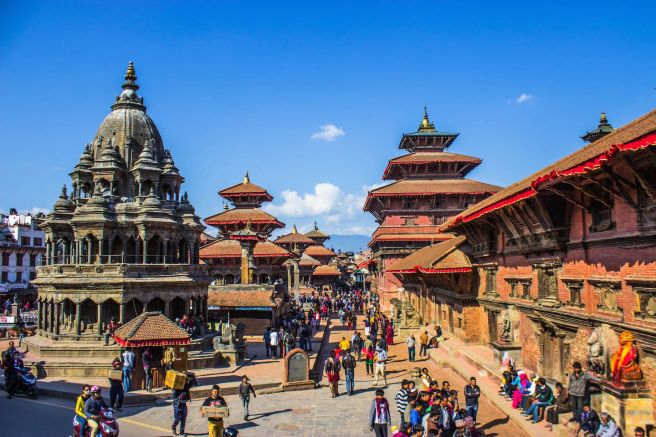
The City of Patan is believed to have been built in the 3rd Century BC by the Kirat dynasty.
It was expanded by Lichhavis in the 6th century A.D. and again by the Mallas in medieval period. The Malla kings ruled the Kathmandu Valley until the ascension of the Shah dynasty. In 1768, King Prithvi Narayan Shah began his campaign to unify Nepal and Patan became a city in the kingdom of Nepal.
The city of Patan offers visitors the chance to see an abundance of exquisite works of religious art and architecture. In addition, adventurous travelers can find many opportunities for trekking, mountain biking, whitewater rafting, aerial exploration of the Kathmandu Valley, and mountaineering. Many tours can be arranged from Kathmandu, just a few kilometers away.
Famous Buddhist attractions of Patan are , the four Ashoka Stupas, marking the four corners of Patan, are symbolic of the Buddhist Wheel of Righteousness (‘Dharma-Chakra’), located at Pulchowk, Lagankhel, Ebahi and in Teta, these mounds are crowned with monuments that the Buddhist Emperor of India, Ashoka, is said to have erected in 250 B.C. Each stupa is different. Three of the mounds are covered in grass, whereas the fourth is a white mound with a colorful monument atop.
In the heart of Patan and the Patan marketplace, Patan Durbar Square is filled with ancient palaces, pagoda temples, stone baths, Hindu and Buddhist statues, bas-relief and engravings, and bronze carvings.
Patan Durbar Square is one of seven monument zones in the Kathmandu Valley that together have been designated a UNESCO World Heritage Site. Also located in the square is the Patan Museum, which houses bronze statues and religious objects, some dating back to the 11th century. This museum, which was originally a Malla palace, is open daily.
Other Buddhist attraction is the Golden Temple (Hiranya Varna Mahavihar), built in the 12th Century by King Bhaskar Verma, and is located just north of Durbar square. This three-roof Buddhist monastery is adorned with a golden facade, four large gateways, a clock tower, and two lion sculptures. Inside are golden images of Buddha, wall carvings, and a prayer wheel.
The Rudra Varna Mahavihar is a Buddhist monastery with a temple and a courtyard that has many fine wood, bronze and stone statues. Kings were crowned in this temple in ancient times.
Just east of Durbar Square lies the Mahaboudha Temple. Made of terracotta tiles, this ‘Temple of the Thousand Buddha’ is modeled after the temple of the same name in Bodhgaya, India, where Buddha is said to have reached enlightenment. Each brick in the structure bears the image of Buddha.
Built by the priest Abhaya Raj, the temple is believed to date back to the late 16th century. It was destroyed by an earthquake in 1934 but was rebuilt (albeit in a somewhat different design).
Milarepa’s Cave
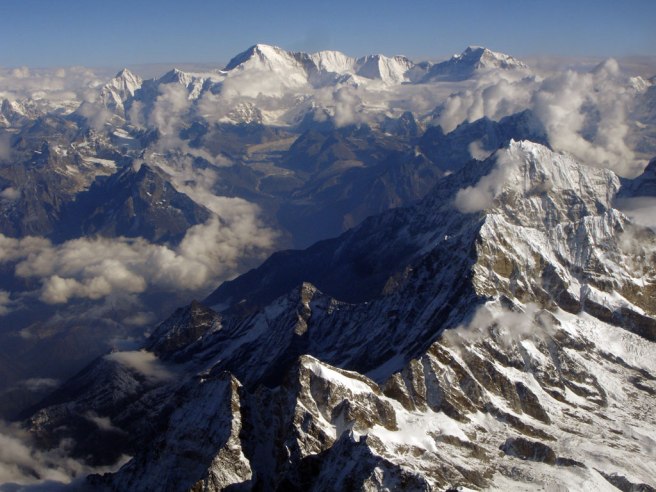
Milarepa’s Cave, shrine dedicated to Milarepa (c. 1052 – c. 1135 CE) Tibet’s great yogi is located near the ‘Annapura Circuit’.
Annapurna Circuit is a trek within the Annapurna mountain range of central Nepal.The total length of the route varies between 160–230 km (100-145 mi), depending on where motor transportation is used and where the trek is ended. The trek rises to an altitude of 5,416m on the Thorung La pass, touching the edge of the Tibetan plateau.
The shrine is closer from the town of Braka, it’s a 3 to 4 hrs hike up to a breathtaking view of the Manang Valley. Expect a full day of hiking from Manang on your acclimating day. One way from Braka, takes about 3 to 4 hrs.
Milarepa meditated here to achieve enlightenment. Finding the entrance to the trek can be a bit tricky. After windy switchbacks you come to a Gompa. Keep going after that and you’ll reach the statue of Milarepa meditating and listening to the song of the mountain.
The Pisang Peak is seen on the far right of the above landscape. It was an absolutely stunning side quest. The energy of this place definitely felt very different. If you look around the scattered rocks, you’ll find some colorful crystals.
Unfortunately, the cave has collapsed now, supposedly the original bow which the hunter used still hangs above Milarepa’s Cave. After hearing Milarepa’s song, the hunter put down his bow and decided to listen to the teachings of Milarepa.
On the way down back to Manang make sure you stop for dinner or food at Braka’s best bakery and restaurant. It’s the last one as you exit Braka. Make sure you get their lasagna, they use local gathered mushrooms. It’s better than any restaurants in Manang.
The Thubchen and Jamba Temples of Lo Monthang
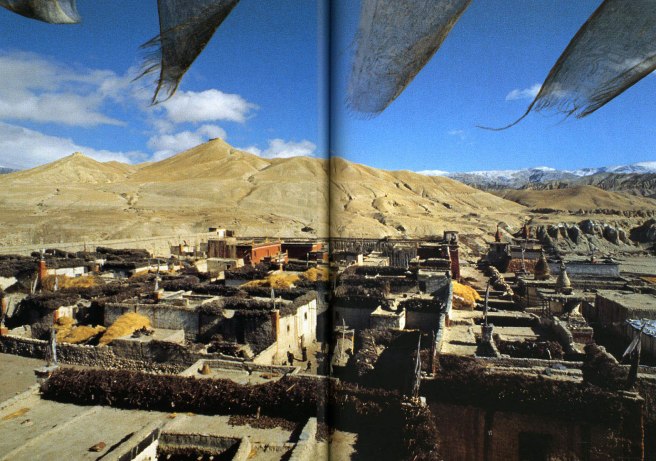
The Tibetan Buddhist temples of Thubchen and Jamba are located in Lo Monthang, the capital of Mustang, which is a semi-autonomous district of Nepal.
For reasons of history and geography, they were not well-known at all. Getting this recognition identifies them as part of the world’s heritage of great art and architecture. They are important in themselves because they are magnificent examples of Tibetan paintings of several different styles and, also, because so little work of equivalent quality has survived in Tibet, where over 95 per cent of the Gombas were destroyed during the Chinese occupation, their statues destroyed and paintings defaced. So these are among the few surviving exemplars of that magnificent culture and period of art.
People interested in Tibetan art were to some extent aware of them, even though Mustang was closed to the outside world until 1992.
You can either reach Monthang via Jomsom by trekking up the Kali Gandaki canyon, or you can fly in. That shortens the trip. From Jomsom, you have to either walk or go by horse. If you walk, it’s about a six-day trek up to Lo Monthang. It is possible to fly by helicopter directly to Lo Monthang, but that’s very rarely done, for several reasons. It’s very expensive. And also, you don’t get altitude acclimatization.
Lo Monthang is a medieval walled city made of mud brick. I’m not sure that anyone could really say with authority how old it is. The temples were built in the late 14th or early 15th century.
According to local legend, the gombas were established in the late 14th or early 15th century by the king of Lo Monthang, together with his prime minister and a Sakyapa abbot named Ngorchen Kunga Zangpo. Although there were also Nyingmapa monks in other villages, the Sakyapa were the predominant order in 13th century Mustang, and in Tibet as well. In fact, it was Sakyapa leaders who converted Kublai Khan and the Mongols to Buddhism.
In return, they were given temporal authority over Tibet for a period back then. In the 14th century, the abbot founded the great Sakyapa monastery called Ngor, which, until its destruction during the Cultural Revolution, was considered one of Tibet’s artistic treasures; he subsequently was involved in establishing the two great gombas of Lo Monthang. It is quite likely that he brought some of the same artists to decorate the temples in Lo Monthang who had also worked on Ngor monastery in Tibet.
Thubchen and Jamba are both very large structures, very imposing. Both are made of mud brick. It seems that Jamba was built first and Thubchen just a few years afterward. They represent different aspects of Buddhism, and this is brought out by both their architecture and the painting. Thubchen, which means essentially “large Buddha,” represents, as it were, the philosophical — almost the more rational — side of Buddhism, and Jamba the more mystical side.
Maratika Cave / Maratika Monastery – ‘The Pashupatinath of the East’
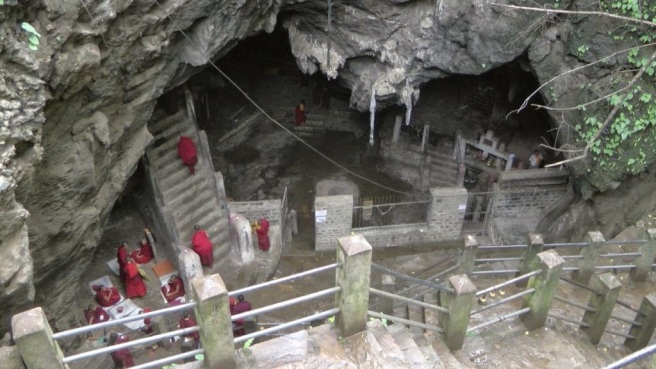
Maratika Cave is located in Khotang District in Nepal, circa 185 km south west of Mount Everest. It is a venerated site of pilgrimage associated with Mandarava, Padmasambhava and longevity.
More commonly known as Haleshi in Nepali language, Maratika is composed of two caves, one upper and the other lower, lodged in a hillside located in Eastern Nepal, 185 kilometres south of Mt. Everest, in remote Khotang District which is devoid of electricity or other modern facilities.
Besides what can be grown locally, all other goods need to be transported there by pack animals or porters. Although it is one of the most famous places of pilgrimage in Nepal mentioned already in the 12th century in Himalayan Buddhist literature, it remains notoriously difficult for a pilgrim to visit.
It takes a minimum of one full day from the nearest airport in a town called Lamidanda to reach. But it is a pleasant trek as you wind your way through the mid-hills, on a lower altitude than the high Himalayas, through villages in which time has stood still. There is also a river which you have to cross by dugout canoe – though with the help of an oarsman – which is tricky because of the strong current
The effort is richly rewarded because of its uniqueness as a place equally sacred to both Hindu and Buddhist, embodying the principle of religious harmony which characterises the Nepalese religious and cultural landscape. The Hindus claim it is an abode of Mahadeva (Shiva) while hiding from the monster Bhasmasur.
They therefore have nicknamed it the ‘Pashupatinath of the East\ Pashupatinath being the most famous Hindu temple in Nepal located in the capital Kathmandu which is dedicated to Shiva.
The Nepalese Buddhists who take the trouble to visit the place primarily include the hardy Mongolian or Tibetan-origin ethnic groups, Tamang and Sherpa, known as high altitude guides and porters, who practice Vajrayana Buddhism. They count it among the six most holy places in the present Buddhist eon. A pilgrimage is often undertaken at Losar, the Tibetan New Year held in February, and is said to guarantee that one will not be reborn into one of the three lower realms, the hell realm, hungry ghost realm or animal realm.
When pilgrims first enter the lower cave, they are expected to blow through a hole in a rock to make a sound like blowing into a conch shell commonly used in both Hindu and Buddhist religious rituals. For Buddhist pilgrims, this is the ‘Cave of the Eight Means of Attainment’, where Guru Rinpoche, an Indian siddha, a practitioner of austerities and magic, was said to have slain a demon. A particularly unique rock formation is pointed out to be in the shape of the demon’s flesh and blood.
Guru Rinpoche is then said to have flown through the roof of the cave leaving a large hole through which the sky is visible. It is called the ‘Sky door’ and 500 Arhats are believed to have come there especially to see it. Many people still go to Maratika to practice Chod, a Vajrayana practice taking an entire night normally performed in a cremation ground. It is thought to reinforce the feeling of impermanence thereby speeding one’s way towards a better rebirth.
Holy water from the caves is called the Nectar of Immortality, said to extend one’s life and purify negative karma, which could otherwise cause rebirth in lower realms. Long-life pills are made from this nectar for the pilgrims to take away with them.
The higher Maratika cave is the place where Guru Rinpoche is supposed to have stayed in retreat before going north to spread Buddhism into Tibet. It was here that Rinpoche and his consort, the Indian princess Mandarava, are believed to have undertaken a taniric practice which endowed them with immortality.
Pilgrims circumambulate both the entire hill housing the caves and also the inside of the caves. Deep down at the bottom of this higher Maratika cave is a large chamber with all kinds of rock formations evocative of gods and goddesses of the Hindu and Buddhist pantheons.
You can test your faith by entering what is called the ‘womb cave’: if you succeed in passing through its narrow entry way, it is believed that your sins are purified and you will achieve a higher rebirth. Buddhists also allege that their stay in the Bardo realm, the intermediary stage following death but preceding rebirth, will be made easier by succeeding in passing through this passage. It changes in size to accommodate even very fat people, and their being able to pass through proves that their karma is good enough. There is also a rock in the shape of a box that grants all wishes, especially of women hoping to get pregnant.
Attesting to the enduring vibrancy of the traditions surrounding Maratika, in a brochure produced by the monastery on location catering towards the pilgrim’s needs, the following guidelines are given: “When visiting this great place, Maratika, the highest profile people should engage in longevity practices, the middle ones should perform offerings, and the general practitioners should make prostrations and also circumambulations.
If one visits this great holy place, one will not need to experience the lower realms” (Ven. Wangchuk, abbot of the Maratika Chimey Takten Choling Monastery, 2013).
The Thrangu Tashi Yangtse Monastery
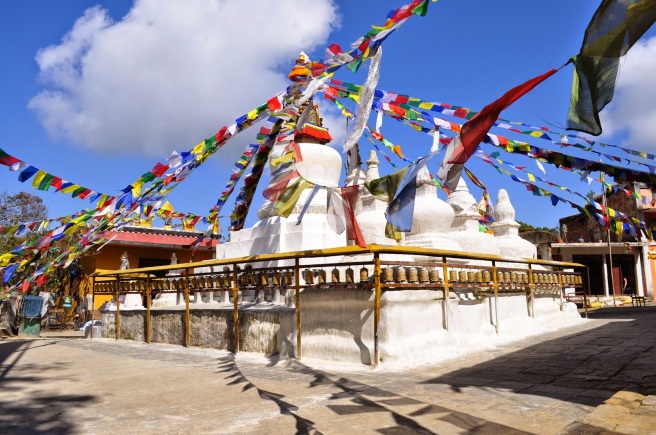
The Thrangu Tashi Yangtse Monastery is a Tibetan Buddhist monastery about 40 km (by road) southeast of Nepal’s capital city Kathmandu.
It lies at the top of the hill in shyampati vdc. It is one of the most beautiful and a center for tourism. The main festivals and mela celebrated here are Kartik Purnima and Buddha Jayanti.
According to the old legend, 6000 years ago, Prince Mahasatwo/Ngingdui Tshenpo observed from the top of the hill, looking towards the forest, the prince discovers a tigress lying near the rock.
Very quickly, he realizes that the tigress was about to die due to hunger with her five little babies still sucking milk from her, survivals of the babies depend on their mother.
Prince Mahasatwo, decides to give his life to the tigress in a bust of love and compassion. So Prince Mahasatwo cuts his body to present his warm blood in the mouth of the mother tiger, and the taste of blood gives the appetite to the starving family.
As the tigress accepts the sacrifice from prince she leaves only the bones.The bones of prince were brought back in the village and buried in the tomb which is actual stupa of Namo Buddha.
Some about 3500 years later, the Buddha came in the village of Sange da Fyafulsa, He conducts 3 tour around the Stupa before he declared that he was the reincarnation of prince Mahasatwo. It was the moment that Gautam Buddha renamed this village which is henceforth the name of Namo Buddha which means Homage to Buddha.
Since it was founded by V.V. Khenchen Thrangu Rinpoche in 1978 the monastery has grown such that today it is home to more than 250 monks. The Thrangu Tashi Yangtse Temple was officially opened on December 5, 2008. The Shree Mangal Dvip Branch School for young monks is also part of the monastery complex.
Asura Cave of Pharping

Asura Cave of Pharping is a cave sacred to Guru Rinpoche, located above the village of Pharping, near Kathmandu, Nepal. It is also known as the ‘Upper cave of Yangleshö’. On the upper left side of the entrance door is the imprint of a hand in the rock.
Tulku Urgyen Rinpoche explains that:
In the innermost recesses of the Asura Cave […] is a tunnel that connects this cave to the Yangleshö Cave down below, about half a mile away. It is not a big hole. Wind passes through this passage and you can feel the draft when sitting near it. Although Padmasambhava could traverse freely through solid matter, he used this narrow tunnel to move between Yangleshö Cave and the upper Asura Cave.
Tulku Tenpo writes:
In the past, in the Asura cave at the border of India and Nepal, Padmasambhava, the great master from Orgyen, and Langchen Palgyi Sengé, one of his main disciples, opened the mandala of the great and glorious Drekpa Kundul.
They gave the spirits the Vajrayana empowerments, and bound them under oath to obey their command. When the twelve Tenma made their pledge and promised to protect Tibet, Guru Rinpoche and Langchen Palgyi Senge poured samaya water on the tongues of the Tenma and placed a symbolic crown, corresponding to their particular Buddha family, on each of their heads.
Then they placed the unchanging vajra in their hands and entrusted them to protect Tibet, and particularly to prevent the tirthikas from ever entering.
Tulku Urgyen Rinpoche restored the cave in the late 80s, early 90s, and built a monastery and three-year retreat centre for the practice of the Chokling Tersar called Pema Ösel Ling, which surrounds the cave.
The three main images enshrined inside the cave are those of Guru Rinpoche, Yangdak Heruka and Vajrakilaya.
Thank you so much for patiently reading, do plan your spiritual visit to Nepal soon.
Tashi Delek!
Courtesy : Old journals of Nepal probably no longer read or published, Jack Chi for notes on Milarepas Gompa, Marcia R. Lieberman for notes on The Thubchen and Jamba Temples of Lo Monthang and Dr. Angela Dietrich for notes on Maratika Cave / Maratika Monastery – ‘The Pashupatinath of the East’.
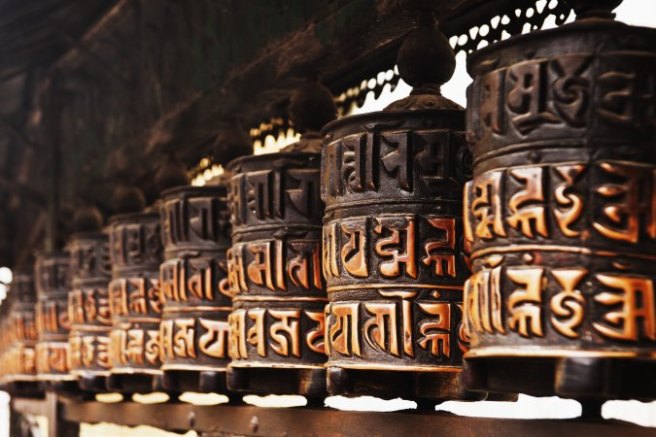
Further Reading :
Article from Kameng Shambhala on Buddhist Pilgrimage to Sri Lanka
Shree Boudhanath Area Development Committee
PDF Document – Buddhism in Nepal
City of Patan ( Lalitpur ) – ‘The City of Beauty’
“Shangri-La” Caves Yield Treasures, Skeletons
Thrangu Tashi Yangtse Monastery
Nepalese Caitya: 1500 Years of Buddhist Votive Architecture in the Kathmandu Valley
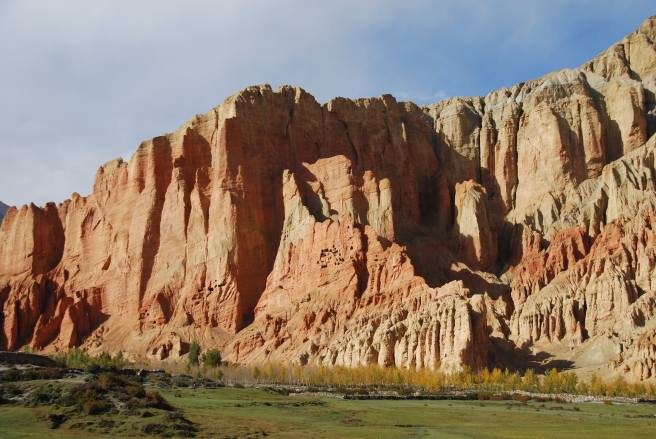


Hi Ruby,
Thank you so much for taking the time out and reading the article.
Do plan a trip to Nepal with your family, it’s an enriching experience, while the Southern Region of Nepal makes you feel that you are “still” somewhere in India, The Northern Region ( where I lived and worked for 3 years ) is more like living in Tibet!
You can refer to the “Dhamma” section of the BLOG for more articles on Buddhism, the link is given below :
https://kamengshambhala.wordpress.com/category/dhamma/
And keep visiting the BLOG for more articles and feel free to share the articles and give your views on the same.
Regards
Kameng
LikeLike
It’s very enlightening to read your article on Nepal, such a beautiful temples n monasteries which I had not seen before. Very interesting to know about Buddhism, a religion of Peace ✌
Looking forward to read more on Buddhism!
Thanks n keep up the good work!
LikeLike